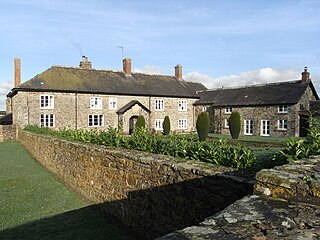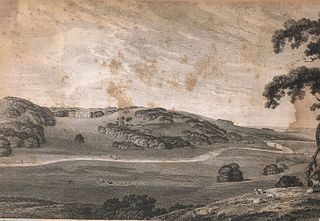
William de Redvers, 5th Earl of Devon, of Tiverton Castle and Plympton Castle, both in Devon, was feudal baron of Plympton in Devon.

John Bourchier, 1st Earl of Bath was named Earl of Bath in 1536. He was feudal baron of Bampton in Devon.

John Bourchier, 2nd Earl of Bath was an Earl in the peerage of England. He also succeeded to the titles of 12th Baron FitzWarin, Baron Daubeney and 4th Count of Eu.

Tawstock is a village, civil parish and former manor in North Devon in the English county of Devon, England. The parish is surrounded clockwise from the north by the parishes of Barnstaple, Bishop's Tawton, Atherington, Yarnscombe, Horwood, Lovacott and Newton Tracey and Fremington. In 2001 it had a population of 2,093. The estimated population in June 2019 was 2,372.

Fulk Bourchier, 10th Baron FitzWarin was the son and heir of William Bourchier, 9th Baron FitzWarin (1407–1470) and the father of John Bourchier, 1st Earl of Bath. He was feudal baron of Bampton in Devon.

Baron FitzWarin was a title in the Peerage of England created by writ of summons for Fulk V FitzWarin in 1295. His family had been magnates for nearly a century, at least since 1205 when his grandfather Fulk III FitzWarin obtained Whittington Castle near Oswestry, which was their main residence and the seat of a marcher lordship.

James Audley, 2nd Baron Audley of Heighley Castle, Staffordshire, was an English peer. He was the son and heir of Nicholas Audley, 1st Baron Audley (1289–1316) by his wife Joan Martin, who was the daughter of William Martin, feudal baron of Barnstaple, and Marcher Lord of Kemes. She was posthumously the eventual sole heiress of her brother William FitzMartin to Barnstaple and Kemes.

Sir Hugh I Courtenay, of Haccombe in Devon, was Sheriff of Devon for 1418/19 and was thrice elected knight of the shire for Devon in 1395, 1397 and 1421. He was a grandson of Hugh de Courtenay, 2nd/10th Earl of Devon (1303–1377), was the younger brother of Edward de Courtenay, 3rd/11th Earl of Devon (1357–1419), "The Blind Earl", and was the grandfather of Edward Courtenay, 1st Earl of Devon (d.1509), KG, created Earl of Devon in 1485 by King Henry VII. He was the link between the senior line of the Courtenay Earls of Devon made extinct following the Battle of Tewkesbury in 1471 and the post-Wars of the Roses creation of a new Earldom for his grandson made in 1485 by King Henry VII.

William de Botreaux (1367–1395) was a baron prominent in South-West Britain.

Sir Neil Loring, KG (also "Neel", "Nele", "Nigel", "Loryng", "Loringe"; Latin: Nigellus; was a medieval English soldier and diplomat and a founding member of the Order of the Garter, established by King Edward III in 1348. The central character in two historical novels by Sir Arthur Conan Doyle, Sir Nigel and The White Company, is loosely based on Neil Loring.

From AD 1066, the feudal barony of Barnstaple was a large feudal barony with its caput at the town of Barnstaple in north Devon, England. It was one of eight feudal baronies in Devonshire which existed in the Middle Ages. In 1236 it comprised 56 knight's fees or individual member manors. The feudal service owed for half the barony in 1274 was the provision to the royal army of two knights or four sergeants for forty days per annum, later commuted to scutage.

Brightley was historically the principal secondary estate within the parish and former manor of Chittlehampton in the county of Devon, England, situated about 2 1/4 miles south-west of the church and on a hillside above the River Taw. From the early 16th century to 1715 it was the seat of the Giffard family, whose mansion house occupied the moated site immediately to the west of the present large farmhouse known as Brightley Barton, a Grade II listed building which incorporates some elements of the earlier house. It is not to be confused with the 12th-century Brightley Priory near Okehampton.
The Manor of Combe Martin was a medieval manor estate in Combe Martin, Devon, England.

Annery was an historic estate in the parish of Monkleigh, North Devon.

The feudal barony of Bampton was one of eight feudal baronies in Devonshire which existed during the mediaeval era, and had its caput at Bampton Castle within the manor of Bampton.

William Bourchier (1407–1470) jure uxoris 9th Baron FitzWarin, was an English nobleman. He was summoned to Parliament in 1448 as Baron FitzWarin in right of his wife Thomasine Hankford.
Fulk I FitzWarin was a powerful marcher lord seated at Whittington Castle in Shropshire in England on the border with Wales, and also at Alveston in Gloucestershire. His grandson was Fulk III FitzWarin the subject of the famous mediaeval legend or "ancestral romance" entitled Fouke le Fitz Waryn, himself the grandfather of Fulk V FitzWarin, 1st Baron FitzWarin (1251–1315).

Ash in the parish of Braunton in North Devon is a historic estate listed in the Domesday Book. The present mansion, known as The Ash Barton estate is a Grade II* listed building.

The historic manor of Tawstock was situated in North Devon, in the hundred of Fremington, 2 miles south of Barnstaple, England. According to Pole the feudal baron of Barnstaple Henry de Tracy made Tawstock his seat, apparently having abandoned Barnstaple Castle as the chief residence of the barony. Many of the historic lords of the manor are commemorated by monuments in St Peter's Church, the parish church of Tawstock which in the opinion of Pevsner contains "the best collection in the county apart from those in the cathedral", and in the opinion of Hoskins "contains the finest collection of monuments in Devon and one of the most notable in England".

Philip Beaumont (1432–1473), lord of the manors of Shirwell in North Devon and of Gittisham in East Devon, was a member of parliament for a constituency in Devon and was Sheriff of Devon in 1469. He was the rightful heir of his elder brother William Beaumont (1427–1453), a substantial landholder, but faced claims to his inheritance from his bastard nephew, John Bodrugan, "The Beaumont Bastard", the illegitimate son of Joan Courtenay, William's wife.


















